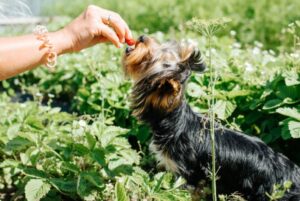You visit an Asian store to get some groceries then you come across a red, shiny, and attractive fruit with spines, you buy this fruit and take it home for you and your family to eat.
On getting home, you notice that your dog is also willing to have a bite of the fruit. But, you are scared this sweet fruit will have any side effects on your dog.
Can dogs eat rambutan? The short answer to this question is YES. Rambutan is safe for dogs, although there are things you should do before serving your dog this fruit.
This blog will provide everything you need to know about the Rambutan fruits and dogs. It incorporates the answers to these queries. What is a Rambutan? Can dogs eat Rambutan?, What are the Health Benefits of Rambutan? Is there any side-effect of eating a lot of Rambutans?
Keep reading so you can find answers to the questions which has left you bothered.
What is a Rambutan?
Rambutan (Nephelium lappaceum) is a fruit that originated in southeast Asia. It is usually reddish. However, it can also appear to be orange, yellow, or green depending on how ripe it is.
The name “Rambutan” was given to this fruit due to the presence of hairs on it. It looks very much like the Lychee and Longan fruit.
Looking at the inside, it is fleshy and white. It has a sweet taste when ripe and a sour taste when unripe.
Can Dogs eat Rambutan?

Yes, dogs can eat Rambutan. However, not all the parts of this fruit are edible. Ensure you feed your dog with this fruit under very close supervision.
The edible and non-edible parts of this fruit will be discussed in the next paragraph.
Is Rambutan Safe for Dogs?
The American Society for the Prevention of Cruelty to Animals (ASPCA) hasn’t said anything or made a positive or negative comment concerning this fruit.
Nonetheless, it is widely accepted everywhere that the flesh of this fruit is completely safe for your dogs.
Just like other fruits, this fruit also has seeds. Swallowing these seeds by your dog will lead to discomfort and health issues. It can completely block the bowel of your dog or stop the digestion of foods.
The seeds of this fruit just like other seeds contain cyanide which is among the chemicals that are harmful to dogs’ health. Allowing your dog to eat this fruit without removing the seeds will expose your dog to cyanide poisoning.
Aside from cyanide poisoning, this fruit also contains a lot of sugar which can increase your dog’s blood sugar content. Therefore, give this fruit to your furry friend as an occasional treat and not a full-course meal.
Symptoms of Cyanide Poisoning in dogs
Cyanide poisoning in dogs is a health issue caused by the ingestion or intake of cyanide. this health condition does present some outward visible signs.
These outward visible signs or symptoms include:
- Frequent Salivation
- Diarrhea and dilated pupils
- Seizures or Convulsions
- Rapid breathing or suffocation
- Lethargy
- Cardiac arrhythmia
Cyanide poisoning requires urgent medication. If you notice any of these symptoms in your pooch after serving him with Rambutan, quickly take him to the vet for treatment.
How to prepare the Rambutan fruit for your dog?

Before serving Rambutan to your dog, you should ensure that it is 100% safe and healthy for consumption.
Below are the steps involved in preparing rambutan for your dog:
- Remove the peel of the fruit and dispose of it in a place where your dog can’t see it.
- Remove the flesh of the fruit.
- Remove the seeds contained in the flesh.
- Ensure that the seeds are not in the vicinity of your dog
- After doing all this, serve your dog with only the flesh
The fourth point is very important, ensure there are no traces of Rambutan seeds in your vicinity. Leaving them around will pose a threat to your dog’s health.
A drop of cyanide in your dog’s mouth can lead to a dangerous health issue, this is the reason why you should ensure that cyanide is 100% free from what your dog wants to eat.
Aside from the peel and the seeds, the flesh of rambutan is 100% safe for dogs.
What are the Nutritional Values of Rambutan?
Rambutan is not just sweet, this fruit offers a variety of health benefits for dogs. It has no cholesterol and fats and doesn’t expose your dog to being obese.
It has a concentrated amount of fiber which helps to reduce constipation in dogs and also eases the movement of undigested food in the bowel.
Vitamin C is another useful mineral present in these fruits. It has vitamin C (Ascorbic acid) which is an antioxidant and helps to improve the immune system for total security against diseases. The vitamin C present in it also helps to fight against bacteria and other pathogens in the digestive system.
Rambutan also contains Phosphorus which helps to improve your dog’s health in general and it also promotes healthy bones and teeth.
Conclusion
The short answer to the question “Can dogs eat Rambutan?” is YES. The flesh of this fruit is edible and 100% safe for dogs. It is also loaded with nutritional values that are beneficial to dogs.
However, before serving this fruit to your dog, ensure you’ve removed the peel and seeds. These are the two components of the fruit that are toxic to dogs.
Frequently Asked Questions (FAQs)
Can Dogs Eat Lychee?
Yes, your dog can eat Lychee, but, just like the Rambutan fruits, you have to remove the peel and also the seeds before offering this fruit to your dog.
Lychee is a highly nutritious fruit for dogs, it contains numerous nutrients such as protein, carbohydrates, and vitamins. It also contains fiber which helps to ease the passage of foods through your dog’s digestive tract.
However, feed your dog only with a ripened Lychee because the unripe one is toxic for dogs.
What Foods Are Toxic to Dogs?
Incorporating natural foods like fruits and veggies into your dog’s diet is an essential thing to do as a pet owner.
However, some natural foods are toxic and should be avoided at all costs. Some of these toxic foods include grapes, avocado, garlic, chives, onion, cherries and a lot more.
Before you go, you can also read: Can dogs eat gushers







Leave a comment